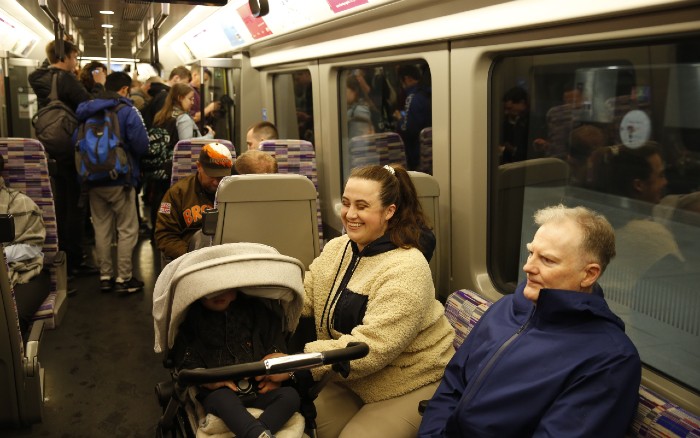Navigating The Elizabeth Line: A Guide To Wheelchair Accessibility

Table of Contents
Station Accessibility on the Elizabeth Line
The Elizabeth Line prioritizes accessibility, with many stations boasting excellent step-free access. However, understanding the specifics of each station is vital for planning a successful journey. Key features across most stations include step-free access via lifts, ramps where necessary, accessible toilets, and platform level boarding for easier train access. Assistance dogs are also welcome.
-
Stations with Excellent Accessibility: Many central London stations, such as Paddington, Canary Wharf, and Tottenham Court Road, offer exemplary step-free access throughout. These stations generally feature multiple lifts, well-maintained ramps, and clearly marked accessible routes.
-
Stations with Limited Accessibility & Alternative Routes: Some stations may have limited step-free access, particularly older sections integrated into the line. For instance, while some platforms might be accessible, others may require stairs. In such cases, it's crucial to use the TfL journey planner (discussed below) to find alternative, fully accessible routes.
-
Station Assistance: Most Elizabeth Line stations have staff available to provide assistance. Don't hesitate to seek help if needed; staff are trained to assist wheelchair users with boarding, navigating the station, and accessing facilities.
Using the Elizabeth Line Trains with a Wheelchair
The Elizabeth Line trains themselves are designed with wheelchair users in mind. Each train features designated wheelchair spaces, usually located near the doors for easy access, priority seating nearby, and sufficient space to maneuver comfortably. Inter-carriage access is typically available, allowing wheelchair users to move between carriages if necessary.
-
Wheelchair Space Size & Location: Wheelchair spaces are generally spacious enough to accommodate standard wheelchairs and accompanying luggage. Their location near the doors ensures a smoother boarding and alighting process.
-
Requesting Assistance: While the trains are designed for accessibility, requesting assistance from train staff is advisable, especially during peak hours or if you require additional help. Staff are trained to provide assistance with boarding, securing wheelchairs, and answering any queries.
-
Potential Challenges: Despite the provisions, potential challenges like crowded carriages during peak times might still occur. Planning your journey during off-peak hours can mitigate such issues.
Planning Your Journey: Accessibility Information and Resources
Careful journey planning is crucial for a stress-free experience. Utilize the resources available to ensure your chosen route is fully accessible.
-
TfL Website & Journey Planner: The Transport for London (TfL) website offers a powerful journey planner that allows you to specify accessibility requirements. Simply input your starting and ending points, select "step-free access," and the planner will show you the most suitable routes. It provides real-time information on service disruptions and delays that might impact accessibility.
-
Apps & Real-time Information: Several apps, including Citymapper and the official TfL Go app, offer similar functionality, providing real-time updates and accessible route planning.
-
Contacting TfL: If you have any specific accessibility concerns or require assistance in planning your journey, contact TfL's customer service directly. They can provide personalized support and address your individual needs.
Addressing Potential Challenges and Obtaining Assistance
Even with careful planning, unexpected challenges might arise. Being prepared and knowing how to address them is essential.
-
Navigating Crowded Platforms: Crowded platforms can be challenging for wheelchair users. Try to travel during off-peak hours whenever possible, or inform station staff of your needs to ensure you can board safely.
-
Reporting Issues: If you encounter a broken lift, inaccessible facilities, or any other accessibility-related issue, report it immediately to station staff. TfL has clear reporting procedures to address such problems swiftly.
-
Emergency Assistance: In case of unforeseen circumstances requiring immediate assistance, contact TfL customer services or use the emergency communication systems available at stations.
Conclusion: Making the Elizabeth Line Accessible for All
The Elizabeth Line represents a significant step towards improving accessible transport in London. Its commitment to step-free access, wheelchair spaces on trains, and readily available assistance demonstrates a dedication to inclusivity. However, continued vigilance and proactive reporting are vital to identifying and addressing potential challenges. Remember to plan your journey in advance using the TfL website or app, specifying your accessibility needs. Report any accessibility issues you encounter to help TfL further improve the service for all wheelchair users. Plan your accessible journey on the Elizabeth Line today, and help us make it even better for all wheelchair users! [Link to TfL Accessibility Page] [Link to TfL Journey Planner]

Featured Posts
-
 Two Pedestrians Killed In Elizabeth City Hit And Run
May 10, 2025
Two Pedestrians Killed In Elizabeth City Hit And Run
May 10, 2025 -
 Dijon Debut D Incendie A La Mediatheque Champollion Bilan Et Circonstances
May 10, 2025
Dijon Debut D Incendie A La Mediatheque Champollion Bilan Et Circonstances
May 10, 2025 -
 Harry Styles Reacts To A Bad Snl Impression
May 10, 2025
Harry Styles Reacts To A Bad Snl Impression
May 10, 2025 -
 Draisaitl Reaches 100 Points Oilers Win Ot Thriller Against Islanders
May 10, 2025
Draisaitl Reaches 100 Points Oilers Win Ot Thriller Against Islanders
May 10, 2025 -
 Leon Draisaitls 100 Point Milestone Oilers Defeat Islanders In Overtime
May 10, 2025
Leon Draisaitls 100 Point Milestone Oilers Defeat Islanders In Overtime
May 10, 2025
